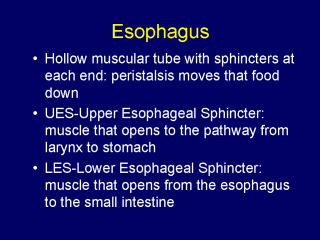 |
The esophagus is
a hollow tube with muscles at each end, called sphincters. When the food is at the point
of the actual swallow, the sphincter muscle at the top of the tube or esophagus opens to
allow the food to pass. Once inside the esophagus, the muscles that make up the walls of
the esophagus move in a wavelike motion called peristalsis which acts to push the food
down the tube (thatís why you can eat while standing on your head- little known fact for
the next time you are on Jeopardy!) Once the top sphincter (Upper Esophageal Sphincter)
has activated, the functioning from there is generally out of the realm of the
speech-language pathologist and becomes the concern of the gastroenterologist. However,
what happens below this point may impact the whole swallowing process. For example, GERD
(gastroesophageal reflux disease) happens with the bottom sphincter muscle (Lower
Esophageal Sphincter) muscle is not remaining closed after food passes through from the
esophagus into the stomach. Therefore, the food is being brought back into the esophagus
and may ultimately go all the way back to the level of the throat and larynx where food
may again be aspirated. |
